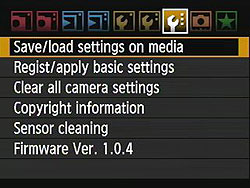
- #Canon mark iii wallpaper menu upgrade
- #Canon mark iii wallpaper menu full
- #Canon mark iii wallpaper menu series
#Canon mark iii wallpaper menu full
#Canon mark iii wallpaper menu upgrade
It is intended to help those trying to decide whether to upgrade their present 1D bodies by sharing my impression of the new camera from the stand point of a wildlife photographer out in the field. My review will be concise and to the point, will not have charts and graphs, and will not cover all the camera's features, just the major new improvements, and assumes the reader is already familiar with the functionality of the current EOS-1D cameras. The EOS-1D X Mark III uses the new Sandisk CFexpress memory cards to achieve lighting speeds of 16-20 fps and 1700 Mb/s 1200 Mb/s read and write speeds respectively. I have put it through a grueling wildlife photo shoot in Hokkaido Island, northern Japan. Therefore, it is logical to buy the camera and put it through my usual real world tests out in the wild.Ĭame out and the new camera arrived in the second half of February. This Mark III model will be Canon's last top-of-the-line DSLR camera. My readers know I have picked the EOS-1D X Mark II as the best all round camera for sports and wildlife photography.
#Canon mark iii wallpaper menu series
This way you can bracket quickly and efficiently to ensure you don’t miss a single frame.Canon EOS-1D X Mark III camera review The Wildlife Ho-tographer Canon EOS-1D X Mark III camera reviewĬanon introduced the EOS-1 series film camera back in 1989, I have made this body my main piece of equipment ever since and have upgraded to every new model through the decades. Then, using auto-exposure bracketing, you would program the camera to take three exposures for every press of the button: one at what it believes to be the correct exposure, as well as one exposure a half-stop over (for a total overexposure of two stops) and a half-stop under (for a total overexposure of just one stop). You would first dial in exposure compensation to -1.5. Take your best guess-let’s say it’s 1.5 stops-and then apply a half-stop increment to the auto-exposure bracketing system of many cameras.

Let’s say you’re unsure of what the correct exposure will be for a given lighting scenario. If this amount of compensation is too much or too little, a quick glance at the LCD and another spin of the dial will help to hone in on exactly how much compensation is necessary in a given lighting scenario.Īnother option is to try combining auto-exposure bracketing with exposure compensation. That way the camera will automatically overexpose by two stops from whatever it determines to be the appropriate exposure. It’s a quick and easy way to account for the environment in which you’re shooting to ensure that, no matter how strong the backlight, your exposures will be more accurate.įor a typical backlighting situation, I would adjust the auto-exposure compensation to +2. On many cameras, the top-of-body LCD will display a small exposure meter, and by turning one of the dials (on my Canon EOS 5D Mark III, it’s the thumb dial on the back of the camera), you can set the exposure compensation to over- or underexpose. Better still, though, is that on many cameras you can adjust the exposure compensation without entering the menus. Here you can activate exposure compensation and dictate whether the camera over- or underexposes, and by how many stops. To use exposure compensation, look for the Auto Exposure Compensation dial on the camera menu. That’s where exposure compensation comes in. Still, though, depending on the size and position of the dark subject against the bright background, it may be impossible to make an automatic exposure that’s right on. The latter will ideally meter from the silhouetted subject alone and better ignore the bright background. To try to compensate, you could change your metering mode to centerweighted or, even better, spot metering.


And it’s going to create an image that’s correctly exposed for the bright background, with the subject in the foreground a total silhouette. Any situation where the backlighting overpowers the light from the front is going to fool your camera’s meter. Common backlighting situations include shooting toward a window or another bright light source indoors, or when outside shooting in the direction of the sun.

These are situations where the light behind the subject is much brighter than the frontal light on the subject. One of the main offenders in the “fool your camera’s exposure meter” arena is backlighting. To put it bluntly, in some scenarios your camera is going to get it wrong. In certain lighting situations, your camera’s auto-exposure capabilities will be limited.


 0 kommentar(er)
0 kommentar(er)
